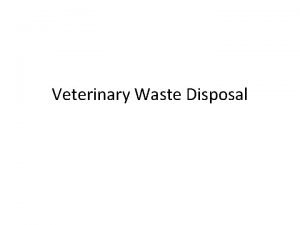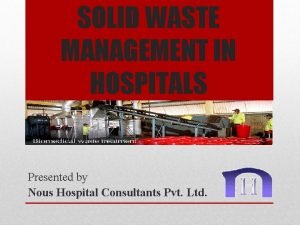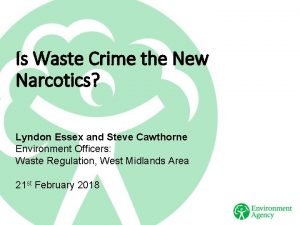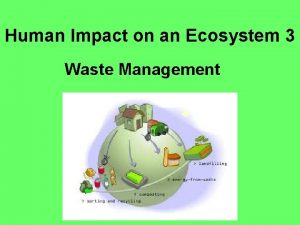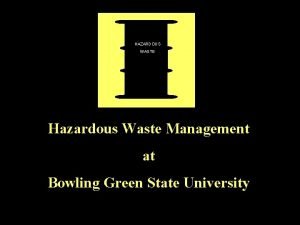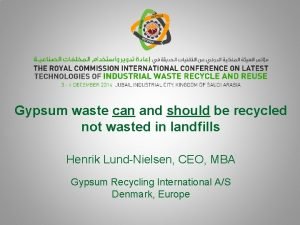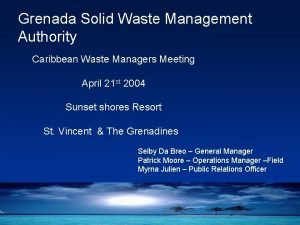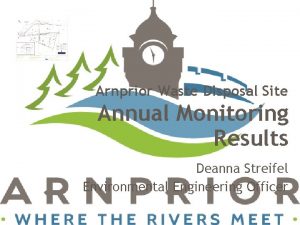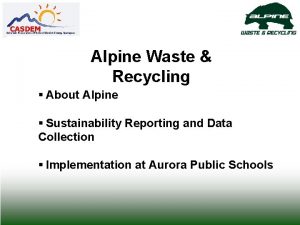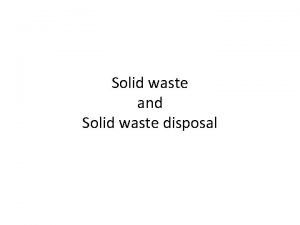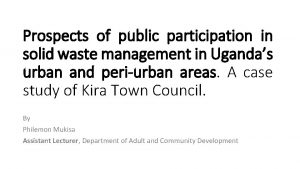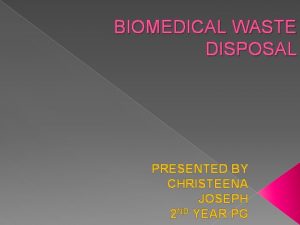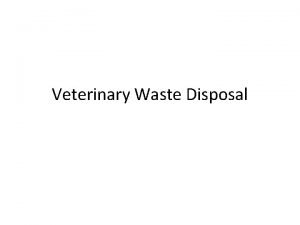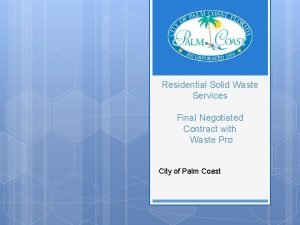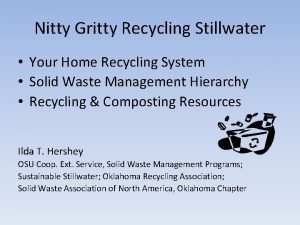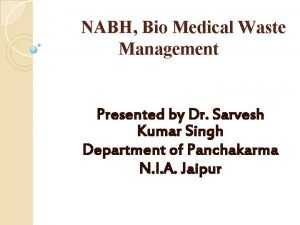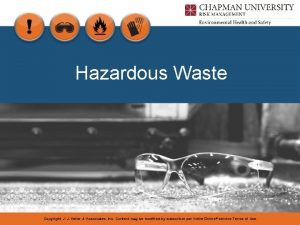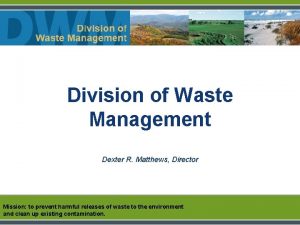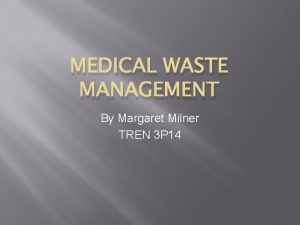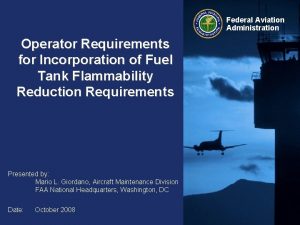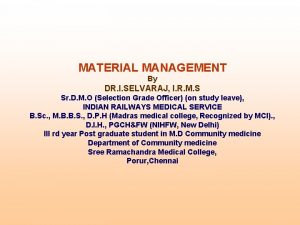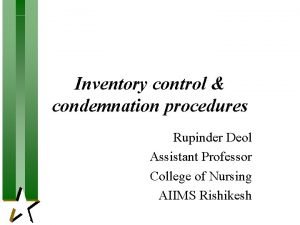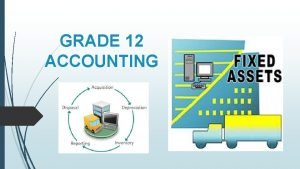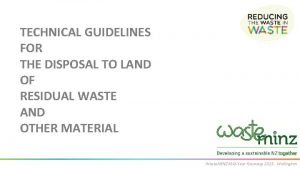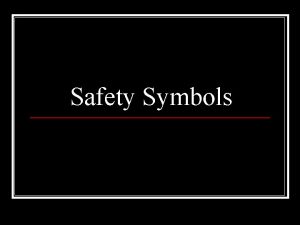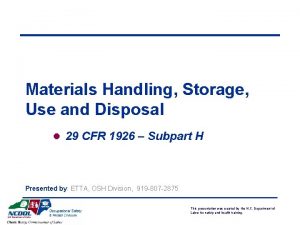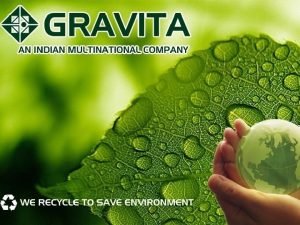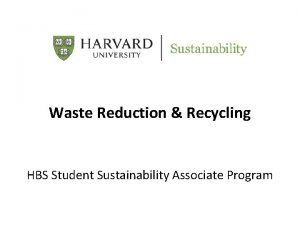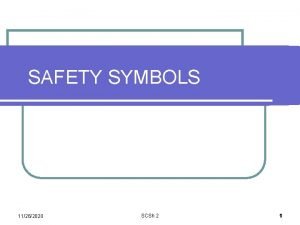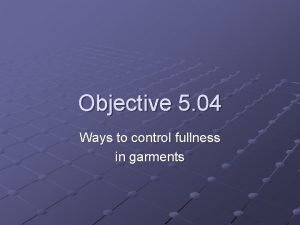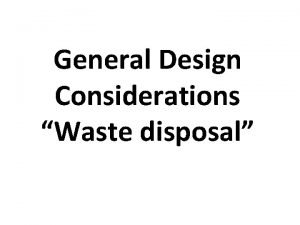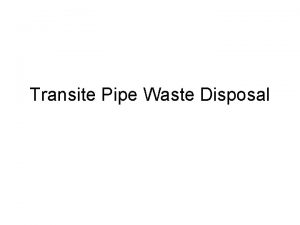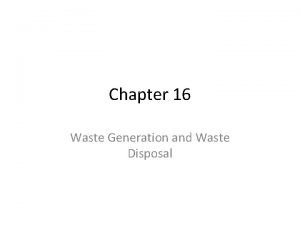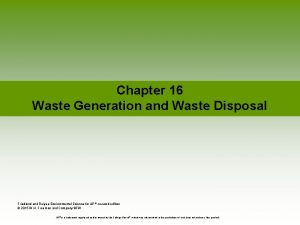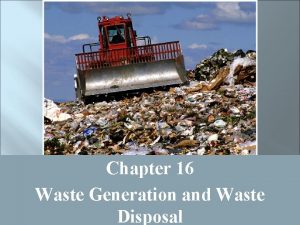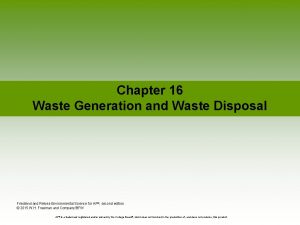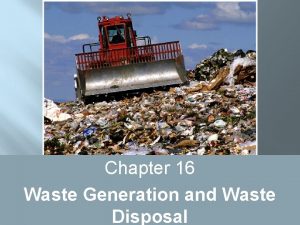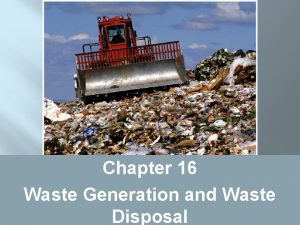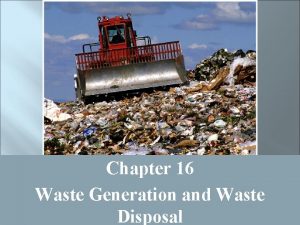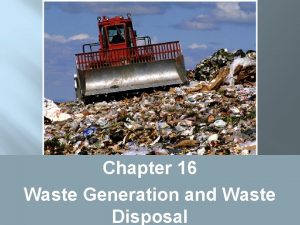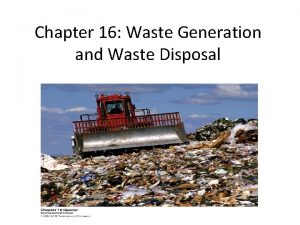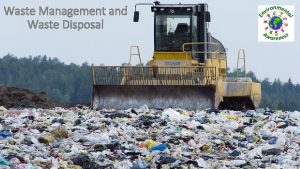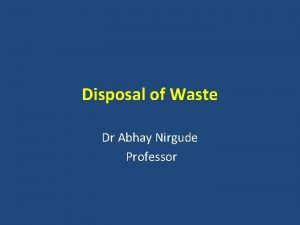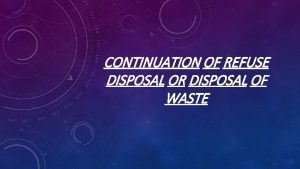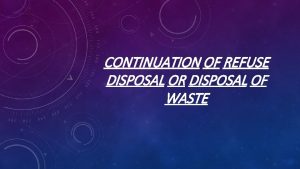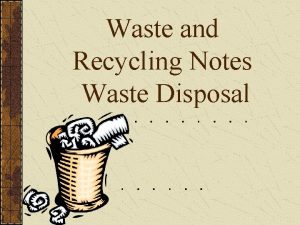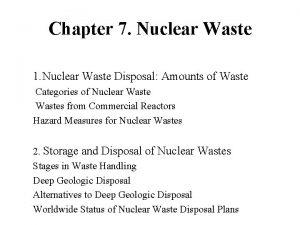Chapter 16 Waste Generation and Waste Disposal Systems








































- Slides: 40

Chapter 16 Waste Generation and Waste Disposal

Systems and Waste Ecological systems input: Plant materials, nutrients, water and energy (sun) Human systems input: same as above but also other materials that are made by humans.

What is waste? Waste is any non-useful products generated within a system. How do we determine what is ‘useful? ’ Detritivours take the waste produced by other animals and use it as food or energy. Humans use animal waste as fertilizer “One man’s trash is another mans treasure. ” Humans are the ONLY organism that produces waste that others cannot use.

Society and waste In 1900 the US recycled almost ALL: metal, wood and glass. As a society becomes more wealthy they gradually generate more waste. With the baby boom after WW II consumption patterns changed. The creation of “one-time use” items and materials allowed for materials to be thrown away. Only one problem… there is NO ‘AWAY’!



Municipal Solid Waste Refuse collected by municipalities from households, small businesses, and institutions such as schools, prisons, municipal buildings and hospitals. 60% comes from households 40% comes from commercial and institutional facilities

Check for understanding By how many metric tons did MSW increase between 1960 -2000? Give two possible reasons for this increase. How much more waste did a person who lived in 2010 generate compared with a person who lived in 1960?

Other types of waste Agricultural waste Mining waste Industrial waste MANY MORE! These are normally processed on site and do not transfer waste to a new location for disposal.

US and the World US produces 2. 2 kg (4. 8 lbs) person/day Japan produces ~ 1. 1 kg (2. 4 lbs) person/day Most of the developing world produces ~. 55 kg (1. 2 lbs) person/day Developed world rages from. 8 -2. 2 kg (1. 8 -4. 8 lbs) Person/day What will happen to MSW in the developing world? WHY?

Content of the solid waste stream Most products are made out of organic compounds, fibers and petroleum products. Waste is generated during the manufacturing process, packaging and disposal. Waste stream--refers to the flow of solid waste that is recycled, incinerated, placed in a solid waste landfill or disposed of in another way.

Homework Identify a specific consumer product that is overly packaged: cell phone, gum, toy truck, etc… Redesign it packaging so it generates less waste.

Exported waste The US has established landfills in many developing countries Impoverished people will try to scavenge waste from dumps. Computer waste can be stripped of heavy metals

Composition of municipal solid waste—US

Composition of Municipal Solid Waste 31% - paper 33%- organic materials (yard waste, food scraps, wood) 12%- plastic 18%- durable goods (appliances, tires)

E-Waste Electronic waste (E-waste) televisions, computers, cell phones that contain toxic metals.

Reduce, Reuse, Recycle Reduce- waste minimization or prevention Reuse- reusing something like a disposable cup more than once Recycle- materials are collected and converted into raw materials and then used to produce new objects



Composting Compost- organic material that has decomposed under controlled conditions to produce an organicrich material.

Vermiculture Composting with worms Worms eat the leftover food and turn it into nutrient rich soil.


Compost Facts Also called Humus Good compost has a pleasant smell and enhances soil quality by adding nutrients to the soil. (N, P, K) Most potting soil is ALL humus (not always the best for plants) Loam= best soil, equal parts sand, silt and clay.

Fate of MSW • Most waste ends up in a landfill

Landfills Sanitary landfills- engineered ground facilities designed to hold MSW with as little contamination of the surrounding environment as possible. Leachate- the water that leaches through the solid waste and removes various chemical compounds with which it comes into contact.

Landfill Features Input MUST be managed! No metals and no organic matter! Plastic or clay lined Pipes below the ground collect leachate When a landfill reaches capacity it is ‘caped’ with soil and clay Water input is minimized because it causes a greater rate of anaerobic digestion Leachate is tested regularly for toxicity


Paying for landfills The municipalituy pays for the construction and they make their $ back in Tipping fees Tipping fee– cost per ton of waste dumped into the landfill. Average ~$35/ton In some places is more if they have less space (NE US)

Famous landfills Lake Shore Drive Mt. Trashmore

AP Quiz What does MSW stand for? (1 pt) What is waste? (1 pt) What percentage of waste qualifies as organic material? (1 pt) What can be done to divert materials away from the waste stream? (3 pts) What is the difference between closed and open loop recycling? (5 pts) Draw and label a picture of a landfill (5 pts) What are some of the components that need to be controlled in a landfill? WHY? ? (5 pts)

Incineration More than ¾ of MSW can be burned. (paper, plastic, food and yard waste are carbon based so they can be burned) Reduces the mass and volume of waste Sometimes the energy can be used for generation of heat and electricity. When used for heat its called a ‘waste-toenergy’ system High efficient incinerators reduce 75% of the mass and 90% of the volume of MSW On average ~ ¼ of the previous volume of MSW is left.

Incineration • Ash is the leftovers from combustion • Bottom ash- what’s left in the furnace • Fly ash- Ash collected outside of the furnace • Ash gets tested by running acidic water through it (leachate) to test for heavy metals, Lead and Cadmium. • Safe ash gets used in construction, roads and bricks. • Toxic ash goes to a toxic dump.

Problems with Incineration • Higher tipping fees ~$70/ton • NIMBY problems, location • Can release VOC’s and metals in exhaust • Ash tends to be more toxic • Need a large amount of MSW delivered daily in order to be efficient. • Communities are less likely to recycle.

Hazardous Waste (HW) Hazardous waste- liquid, solid, gaseous, or sludge waste material that is harmful to humans or ecosystems. 20, 000 HW generators = 40 million tons of HW ~5% is recycled Most is the byproduct of industry: cleaning machines, making computers. Small businesses- Dry cleaning, car repair, small farms Households- oven cleaners , batteries and lawn fertilizers.

Dealing with HW Collection sites for hazardous waste must be staffed with specially trained personnel. Hazardous waste must be treated before disposal. EPA – ‘less env. harmful’ Sending it through a series of chemical reactions to neutralize it.

Laws Resource Conservation and Recovery Act (RCRA)designed to reduce or eliminate hazardous waste. Also know as “cradle-to-grave” tracking. RCRA ensures that hazardous waste is tracked and properly disposed of.

Laws Comprehensive Environmental Response, Compensation, and Liability Act (CERCLA)- also know as “Superfund Act”. Puts a tax on the chemical and petroleum industries. This revenue is used to cleanup abandoned and nonoperating hazardous waste sites where a responsible party cannot be found. Requires the federal government to respond directly to the release of substance that may pose a threat to human health or the environment

Brownfields Contaminated industrial or commercial sites that may require environmental cleanup before they can be redeveloped or expanded. Old factories, industrial areas and waterfronts, dry cleaners, gas stations, landfills, and rail yards are some examples.

Superfund sites

Integrated Waste Management A method that seeks to develop as many options as possible, to reduce environmental harm and cost. Reduction, recycling, composting, landfills, and incineration are some ways IWM is utilized.
 Waste disposal lindsay
Waste disposal lindsay Veterinary waste disposal
Veterinary waste disposal Color coding for waste disposal
Color coding for waste disposal Waste disposal lyndon
Waste disposal lyndon 3r solid waste management
3r solid waste management Color coding for waste disposal
Color coding for waste disposal Waste disposal bowling green
Waste disposal bowling green Disposal of gypsum waste
Disposal of gypsum waste Trash haulers grenada
Trash haulers grenada Arnprior waste disposal site
Arnprior waste disposal site Alpine waste disposal
Alpine waste disposal Medico waste disposal
Medico waste disposal Trench method of waste disposal
Trench method of waste disposal Solid waste disposal introduction
Solid waste disposal introduction Medical waste introduction
Medical waste introduction Veterinary waste disposal legislation
Veterinary waste disposal legislation Flow chart of transfer station
Flow chart of transfer station Waste pro palm coast
Waste pro palm coast Stillwater ok recycling
Stillwater ok recycling Blood bag discarded in
Blood bag discarded in Hazardous waste transportation
Hazardous waste transportation Grenada trash haulers
Grenada trash haulers Matthews waste disposal
Matthews waste disposal Milner waste management
Milner waste management First generation antipsychotics
First generation antipsychotics We worship you hallelujah
We worship you hallelujah Faa nitrogen generation systems
Faa nitrogen generation systems Retention and disposal of gmp documents
Retention and disposal of gmp documents Objective of material management
Objective of material management Condemnation in material management
Condemnation in material management Property, plant and equipment note
Property, plant and equipment note Decision support systems and intelligent systems
Decision support systems and intelligent systems Technical guidelines for disposal to land
Technical guidelines for disposal to land Disposal alert
Disposal alert When disposal materials are dropped
When disposal materials are dropped Anatomy of a garbage disposal
Anatomy of a garbage disposal Certified scrap lead acid batteries recycler
Certified scrap lead acid batteries recycler Hbs disposal
Hbs disposal Disposal alert symbol
Disposal alert symbol Methods of controlling fullness
Methods of controlling fullness Disposal consideration
Disposal consideration

